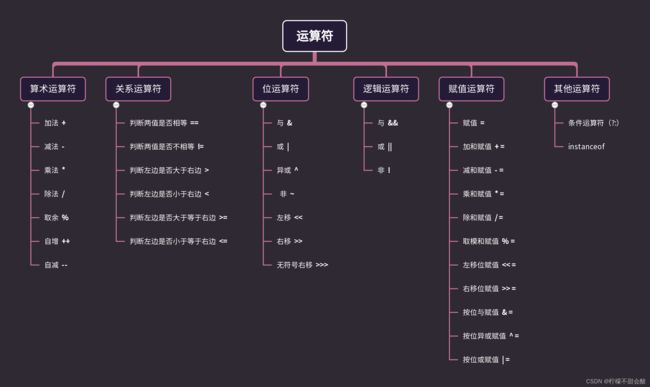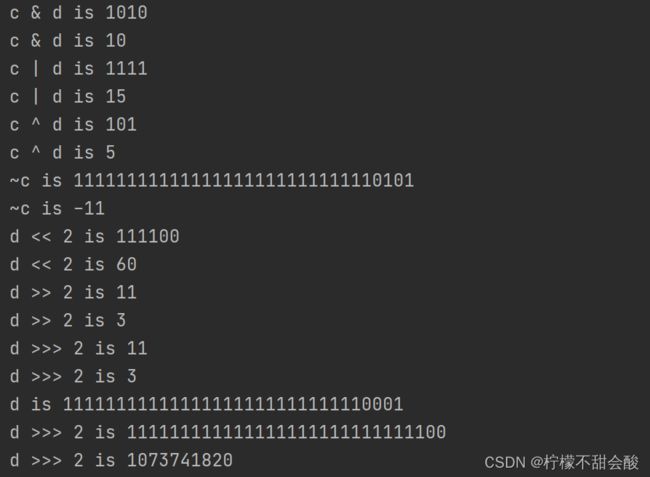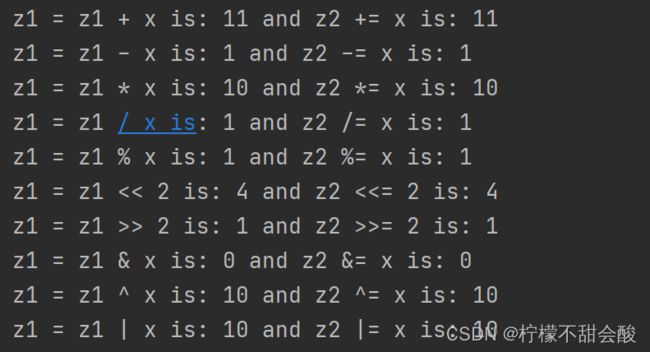Java学习笔记——运算符
目录
一、算术运算符
二、关系运算符
三、位运算符
四、逻辑运算符
五、赋值运算符
六、其他运算符
七、代码
Java的运算符可分为以下几组:
算术运算符、关系运算符、位运算符、逻辑运算符、赋值运算符、其他运算符
 一、算术运算符
一、算术运算符
代码实例 1
int a = 3;
int b = 5;
/* 算术运算符 */
System.out.println("a + b = " + (a + b)); // a + b = 3 + 5 = 8
System.out.println("a - b = " + (a - b)); // a - b = 3 - 5 = -2
System.out.println("a * b = " + (a * b)); // a * b = 3 * 5 = 15
System.out.println("b / a = " + (b / a)); // b / a = 5 / 3 = 1 "/"整除
System.out.println("b % a = " + (b % a)); // b % a = 5 % 3 = 2 "%"取余
System.out.println("a++ = " + (a++)); // a++ 自增,先进行表达式运算,再自增。因此输出为a = 3,之后a = a + 1 = 4
System.out.println("a-- = " + (a--)); // a-- 自减,先进行表达式运算,再自减。因此输出为a = 4,之后a = a - 1 = 3输出结果1
二、关系运算符
代码实例2
int a = 3;
int b = 5;
/* 关系运算符 */
System.out.println("a == b is " + (a == b)); // a == b --> 3 != 5 --> false
System.out.println("a != b is " + (a != b)); // a != b --> 3 != 5 --> true
System.out.println("a > b is " + (a > b)); // a > b --> 3 < 5 --> false
System.out.println("a < b is " + (a < b)); // a < b --> 3 < 5 --> true
System.out.println("b >= a is " + (b >= a)); // b >= a --> 5 >= 3 --> true
System.out.println("b <= a is " + (b <= a)); // b <= a --> 5 >= 3 --> fasle
输出结果2
三、位运算符
代码实例3
/* 位运算符 */
int c = 10; // 二进制c --> 0000 1010
int d = 15; // 二进制d --> 0000 1111
int num = 0;
// 对应位都是1,则1,否则0
num = c & d;
System.out.println("c & d is " + Integer.toBinaryString(num));
System.out.println("c & d is " + (num));
/* 0000 1010
& 0000 1111
------------
0000 1010
* */
// 存在1,则1,否则0
num = c | d;
System.out.println("c | d is " + Integer.toBinaryString(num));
System.out.println("c | d is " + (num));
/* 0000 1010
| 0000 1111
------------
0000 1111
* */
// 相反,则1,否则0
num = c ^ d;
System.out.println("c ^ d is " + Integer.toBinaryString(num));
System.out.println("c ^ d is " + (num));
/* 0000 1010
^ 0000 1111
------------
0000 0101
* */
// 对应位取反
num = ~c;
System.out.println("~c is " + Integer.toBinaryString(num));
System.out.println("~c is " + (num));
/* ~ 0000 0000 0000 0000 0000 0000 0000 1010
------------------------------------------
1111 1111 1111 1111 1111 1111 1111 0101
* */
// 向左移位,低位补0
num = d << 2;
System.out.println("d << 2 is " + Integer.toBinaryString(num));
System.out.println("d << 2 is " + (num));
/* 0000 1111
------------
0011 1100
* */
// 向右移位,高位补0
num = d >> 2;
System.out.println("d >> 2 is " + Integer.toBinaryString(num));
System.out.println("d >> 2 is " + (num));
/* 0000 1111
------------
0000 0011
* */
// 正数右移,高位补0;负数右移,高位补1
num = d >>> 2;
System.out.println("d >>> 2 is " + Integer.toBinaryString(num));
System.out.println("d >>> 2 is " + (num));
/* 0000 1111
------------
0000 0011
* */
num = -d;
System.out.println("d is " + Integer.toBinaryString(num));
num = num >>> 2;
System.out.println("d >>> 2 is " + Integer.toBinaryString(num));
System.out.println("d >>> 2 is " + (num));
// 负数的二进制:先取反。再 + 1
/* 0000 0000 0000 0000 0000 0000 0000 1111 1111 1111 1111 1111 1111 1111 1111 0000
----------------------------------------- --> -----------------------------------------
1111 1111 1111 1111 1111 1111 1111 0000 1111 1111 1111 1111 1111 1111 1111 0001
* */
// 负数右移
/* 1111 1111 1111 1111 1111 1111 1111 0000
-----------------------------------------
0011 1111 1111 1111 1111 1111 1111 1100
* */输出结果3
四、逻辑运算符
代码实例4
/* 逻辑运算符 */
boolean b1 = true;
boolean b2 = false;
// && 全true,则true,否则false; || 有一个true,则true,否则false; !取反
System.out.println("b1 && b2 = " + (b1 && b2));
System.out.println("b1 || b2 = " + (b1 || b2));
System.out.println("!(b1 && b2) = " + !(b1 && b2));输出结果4
五、赋值运算符
代码实例5
/* 赋值运算符 */
final int x = 10;
int z1 = 1;
int z2 = 1;
z1 = z1 + x;
z2 += x;
System.out.println("z1 = z1 + x is: " + z1 + " and z2 += x is: " + z2);
z1 = z1 - x;
z2 -= x;
System.out.println("z1 = z1 - x is: " + z1 + " and z2 -= x is: " + z2);
z1 = z1 * x;
z2 *= x;
System.out.println("z1 = z1 * x is: " + z1 + " and z2 *= x is: " + z2);
z1 = z1 / x;
z2 /= x;
System.out.println("z1 = z1 / x is: " + z1 + " and z2 /= x is: " + z2);
z1 = z1 % x;
z2 %= x;
System.out.println("z1 = z1 % x is: " + z1 + " and z2 %= x is: " + z2);
z1 = z1 << 2;
z2 <<= 2;
System.out.println("z1 = z1 << 2 is: " + z1 + " and z2 <<= 2 is: " + z2);
z1 = z1 >> 2;
z2 >>= 2;
System.out.println("z1 = z1 >> 2 is: " + z1 + " and z2 >>= 2 is: " + z2);
z1 = z1 & x;
z2 &= x;
System.out.println("z1 = z1 & x is: " + z1 + " and z2 &= x is: " + z2);
z1 = z1 ^ x;
z2 ^= x;
System.out.println("z1 = z1 ^ x is: " + z1 + " and z2 ^= x is: " + z2);
z1 = z1 | x;
z2 |= x;
System.out.println("z1 = z1 | x is: " + z1 + " and z2 |= x is: " + z2);输出结果5
六、其他运算符
1、条件运算符 (?:)
-
variable x = (expression) ? value if true : value if false
代码实例6
// 条件运算符
int m = 10;
int n;
// 若m == 1为真,则n = 10,否则n = 20
n = (m == 1) ? 10: 20;
System.out.println("n: " + n);
// 若m == 10为真,则n = 10,否则n = 20
n = (m == 10) ? 10: 20;
System.out.println("n: " + n);输出结果6
2、instanceof运算符
- instanceof运算符用于判断该对象是否是一个特定类型,是返回true,否则false。
代码实例7
// instanceof运算符
String name = "Jack";
System.out.println(name instanceof String);输出结果7
七、代码
public class Day3 {
public static void main(String[] args){
int a = 3;
int b = 5;
/* 算术运算符 */
System.out.println("a + b = " + (a + b)); // a + b = 3 + 5 = 8
System.out.println("a - b = " + (a - b)); // a - b = 3 - 5 = -2
System.out.println("a * b = " + (a * b)); // a * b = 3 * 5 = 15
System.out.println("b / a = " + (b / a)); // b / a = 5 / 3 = 1 "/"整除
System.out.println("b % a = " + (b % a)); // b % a = 5 % 3 = 2 "%"取余
System.out.println("a++ = " + (a++)); // a++ 自增,先进行表达式运算,再自增。因此输出为a = 3,之后a = a + 1 = 4
System.out.println("a-- = " + (a--)); // a-- 自减,先进行表达式运算,再自减。因此输出为a = 4,之后a = a - 1 = 3
/* 关系运算符 */
System.out.println("a == b is " + (a == b)); // a == b --> 3 != 5 --> false
System.out.println("a != b is " + (a != b)); // a != b --> 3 != 5 --> true
System.out.println("a > b is " + (a > b)); // a > b --> 3 < 5 --> false
System.out.println("a < b is " + (a < b)); // a < b --> 3 < 5 --> true
System.out.println("b >= a is " + (b >= a)); // b >= a --> 5 >= 3 --> true
System.out.println("b <= a is " + (b <= a)); // b <= a --> 5 >= 3 --> fasle
/* 位运算符 */
int c = 10; // 二进制c --> 0000 1010
int d = 15; // 二进制d --> 0000 1111
int num = 0;
// 对应位都是1,则1,否则0
num = c & d;
System.out.println("c & d is " + Integer.toBinaryString(num));
System.out.println("c & d is " + (num));
/* 0000 1010
& 0000 1111
------------
0000 1010
* */
// 存在1,则1,否则0
num = c | d;
System.out.println("c | d is " + Integer.toBinaryString(num));
System.out.println("c | d is " + (num));
/* 0000 1010
| 0000 1111
------------
0000 1111
* */
// 相反,则1,否则0
num = c ^ d;
System.out.println("c ^ d is " + Integer.toBinaryString(num));
System.out.println("c ^ d is " + (num));
/* 0000 1010
^ 0000 1111
------------
0000 0101
* */
// 对应位取反
num = ~c;
System.out.println("~c is " + Integer.toBinaryString(num));
System.out.println("~c is " + (num));
/* ~ 0000 0000 0000 0000 0000 0000 0000 1010
------------------------------------------
1111 1111 1111 1111 1111 1111 1111 0101
* */
// 向左移位,低位补0
num = d << 2;
System.out.println("d << 2 is " + Integer.toBinaryString(num));
System.out.println("d << 2 is " + (num));
/* 0000 1111
------------
0011 1100
* */
// 向右移位,高位补0
num = d >> 2;
System.out.println("d >> 2 is " + Integer.toBinaryString(num));
System.out.println("d >> 2 is " + (num));
/* 0000 1111
------------
0000 0011
* */
// 正数右移,高位补0;负数右移,高位补1
num = d >>> 2;
System.out.println("d >>> 2 is " + Integer.toBinaryString(num));
System.out.println("d >>> 2 is " + (num));
/* 0000 1111
------------
0000 0011
* */
num = -d;
System.out.println("d is " + Integer.toBinaryString(num));
num = num >>> 2;
System.out.println("d >>> 2 is " + Integer.toBinaryString(num));
System.out.println("d >>> 2 is " + (num));
// 负数的二进制:先取反。再 + 1
/* 0000 0000 0000 0000 0000 0000 0000 1111 1111 1111 1111 1111 1111 1111 1111 0000
----------------------------------------- --> -----------------------------------------
1111 1111 1111 1111 1111 1111 1111 0000 1111 1111 1111 1111 1111 1111 1111 0001
* */
// 负数右移
/* 1111 1111 1111 1111 1111 1111 1111 0000
-----------------------------------------
0011 1111 1111 1111 1111 1111 1111 1100
* */
/* 逻辑运算符 */
boolean b1 = true;
boolean b2 = false;
// && 全true,则true,否则false; || 有一个true,则true,否则false; !取反
System.out.println("b1 && b2 = " + (b1 && b2));
System.out.println("b1 || b2 = " + (b1 || b2));
System.out.println("!(b1 && b2) = " + !(b1 && b2));
/* 赋值运算符 */
final int x = 10;
int z1 = 1;
int z2 = 1;
z1 = z1 + x;
z2 += x;
System.out.println("z1 = z1 + x is: " + z1 + " and z2 += x is: " + z2);
z1 = z1 - x;
z2 -= x;
System.out.println("z1 = z1 - x is: " + z1 + " and z2 -= x is: " + z2);
z1 = z1 * x;
z2 *= x;
System.out.println("z1 = z1 * x is: " + z1 + " and z2 *= x is: " + z2);
z1 = z1 / x;
z2 /= x;
System.out.println("z1 = z1 / x is: " + z1 + " and z2 /= x is: " + z2);
z1 = z1 % x;
z2 %= x;
System.out.println("z1 = z1 % x is: " + z1 + " and z2 %= x is: " + z2);
z1 = z1 << 2;
z2 <<= 2;
System.out.println("z1 = z1 << 2 is: " + z1 + " and z2 <<= 2 is: " + z2);
z1 = z1 >> 2;
z2 >>= 2;
System.out.println("z1 = z1 >> 2 is: " + z1 + " and z2 >>= 2 is: " + z2);
z1 = z1 & x;
z2 &= x;
System.out.println("z1 = z1 & x is: " + z1 + " and z2 &= x is: " + z2);
z1 = z1 ^ x;
z2 ^= x;
System.out.println("z1 = z1 ^ x is: " + z1 + " and z2 ^= x is: " + z2);
z1 = z1 | x;
z2 |= x;
System.out.println("z1 = z1 | x is: " + z1 + " and z2 |= x is: " + z2);
/* 其他运算符 */
// 条件运算符
int m = 10;
int n;
// 若m == 1为真,则n = 10,否则n = 20
n = (m == 1) ? 10: 20;
System.out.println("n: " + n);
// 若m == 10为真,则n = 10,否则n = 20
n = (m == 10) ? 10: 20;
System.out.println("n: " + n);
// instanceof运算符
String name = "Jack";
System.out.println(name instanceof String);
}
}





